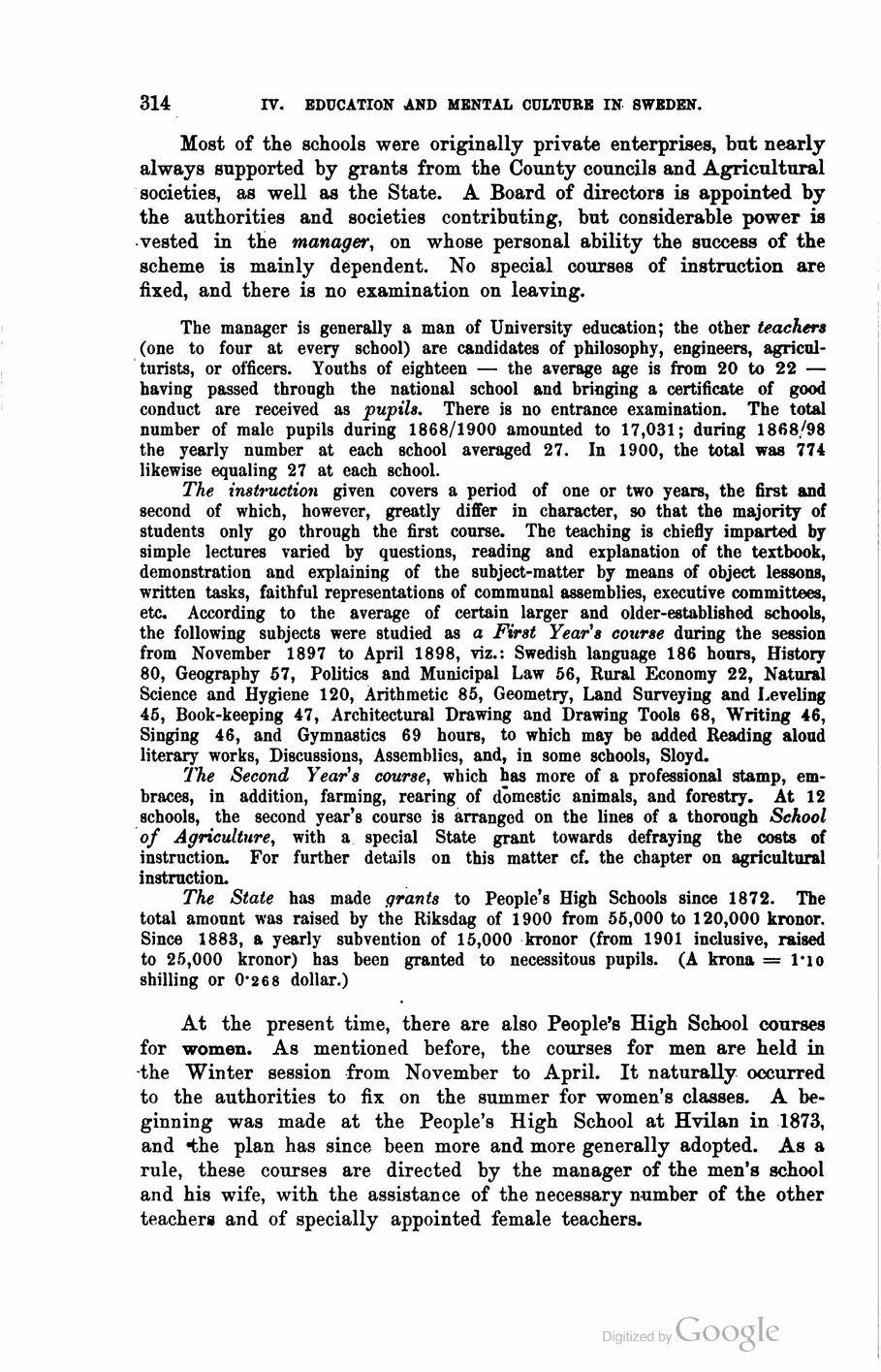
Full resolution (JPEG) - On this page / på denna sida - First part - IV. Education and Mental Culture - 1. Popular Education - People's High Schools, Workmen's Institutes, and University Extension, by G. Aldén, Deputy Editor, Stockholm

<< prev. page << föreg. sida << >> nästa sida >> next page >>
Below is the raw OCR text
from the above scanned image.
Do you see an error? Proofread the page now!
Här nedan syns maskintolkade texten från faksimilbilden ovan.
Ser du något fel? Korrekturläs sidan nu!
This page has never been proofread. / Denna sida har aldrig korrekturlästs.
314
IV. EDUCATION AND MENTAL CULTURE IN SWEDEN.
Most of the schools were originally private enterprises, but nearly
always supported by grants from the County councils and Agricultural
societies, as well as the State. A Board of directors is appointed by
the authorities and societies contributing, but considerable power is
vested in the manager, on whose personal ability the success of the
scheme is mainly dependent. No special courses of instruction are
fixed, and there is no examination on leaving.
The manager is generally a man of University education; the other teachers
(one to four at every school) are candidates of philosophy, engineers,
agriculturists, or officers. Youths of eighteen — the average age is from 20 to 22 —
having passed through the national school and bringing a certificate of good
conduct are received as pupils. There is no entrance examination. The total
number of male pupils during 1868/1900 amounted to 17,031; during 1868/98
the yearly number at each school averaged 27. In 1900, the total was 774
likewise equaling 27 at each school.
The instruction given covers a period of one or two years, the first and
second of which, however, greatly differ in character, so that the majority of
students only go through the first course. The teaching is chiefly imparted by
simple lectures varied by questions, reading and explanation of the textbook,
demonstration and explaining of the subject-matter by means of object lessons,
written tasks, faithful representations of communal assemblies, executive committees,
etc. According to the average of certain larger and older-established schools,
the following subjects were studied as a First Year’s course during the session
from November 1897 to April 1898, viz.: Swedish language 186 hours, History
80, Geography 57, Politics and Municipal Law 56, Rural Economy 22, Natural
Science and Hygiene 120, Arithmetic 85, Geometry, Land Surveying and Leveling
45, Book-keeping 47, Architectural Drawing and Drawing Tools 68, Writing 46,
Singing 46, and Gymnastics 69 hours, to which may be added Reading aloud
literary works, Discussions, Assemblies, and, in some schools, Sloyd.
The Second Year’s course, which has more of a professional stamp,
embraces, in addition, farming, rearing of domestic animals, and forestry. At 12
schools, the second year’s course is arranged on the lines of a thorough School
of Agriculture, with a special State grant towards defraying the costs of
instruction. For further details on this matter cf. the chapter on agricultural
instruction.
The State has made grants to People’s High Schools since 1872. The
total amount was raised by the Riksdag of 1900 from 55,000 to 120,000 kronor.
Since 1883, a yearly subvention of 15,000 kronor (from 1901 inclusive, raised
to 25,000 kronor) has been granted to necessitous pupils. (A krona = l-io
shilling or 0’2 6 8 dollar.)
At the present time, there are also People’s High School courses
for women. As mentioned before, the courses for men are held in
-the "Winter session from November to April. It naturally occurred
to the authorities to fix on the summer for women’s classes. A
beginning was made at the People’s High School at Hvilan in 1873,
and -the plan has since been more and more generally adopted. As a
rule, these courses are directed by the manager of the men’s school
and his wife, with the assistance of the necessary number of the other
teachers and of specially appointed female teachers.
<< prev. page << föreg. sida << >> nästa sida >> next page >>